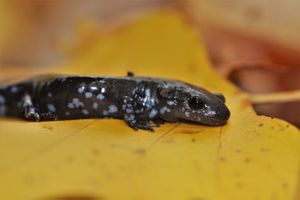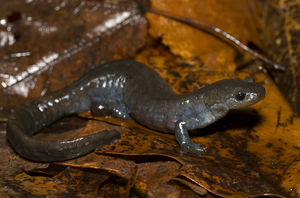Blue-spotted salamander
General Description

The Blue-spotted Salamander (Ambystoma laterlae) is black with blue spots and specks all over the body, sides, arms, and tail. A total of 12-14 costal grooves run from the tip of the head to the end of the body. In addition, costal grooves are vertical creases that run along their bodies and have the effect of increasing the skins surface area to increase water absorption. Salamanders cannot live without having wet skin, so this attribute is of great importance [5]. Adults grow to be 3-5 inches ( 7.6-14 cm), females are slightly larger than males [1]. Additionally, they have five toes on both of their back feet and four on each of their front feet.
Geographic Distribution & Habitat
The geographic range of this species extends north from the New England area to as far west as Wisconsin and Minnesota. Tolerant of cold temperatures, these Blue-spotted Salamanders are found in both deciduous timbers and coniferous forests with moist woodlands. The existence of vernal pools that maintain water all the way through summer is essential to the sustainability of their habitat. Most likely, they would be found in the leaf litter and logs located along the vernal pools from early spring to mid-fall. During the warmer months, they may even venture out in the open during rain showers [1].
Like many amphibian species, their habitat is threatened by human development. Commercial, residential, and industrial construction all have a negative impact on their populations and habitats. Blue-spotted Salamanders have been classified as Least Concern by the IUCN Red List [2].

Ecology
Their diet consists primarily of small invertebrates such as snails, earthworms, centipedes, and spiders. Moreover, salamanders may eat aquatic insects such as water fleas and copepods, especially if they are in breeding pools. When not breeding in the vernal pools, they prefer to stay hidden in darkness under logs and fallen leaves. During the night or in the process of a storm, they will go out a lot more because of the abundant moisture that they are provided. If danger exists, these salamanders are capable of producing toxic secretions as a form of defense. [1] The poisonous secretions are part of their defense mechanism for protecting themselves from predators. The unappealing taste deters predators from consuming them.
Reproduction
Breeding season begins in late March to early April with the salamanders migrating to the vernal pools. Courtship ensues with the male using his snout to nuzzle and nudge the female. He then mounts the female, using his front legs to hold her body, and then rubs his chin on her head. This can continue for several hours with the pair periodically coming to the surface for air and then returning underwater.
After the courtship the male releases the female and deposits a spermatophore in front of her. If all goes well the female will move over the spermatophore and take it into her cloaca. Males are able to produce 10-40 spermatophores during one breeding season, although many of these are not used by females. Females lay 1-12 eggs per clutch, which are laid in a gelatinous mass usually on sticks, leaves, or rocks underneath the water. Eggs will hatch in three to five weeks. The larvae go through their metamorphosis in the late summer and will continue their life cycle on land [1].

Relations with Jefferson's Salamander
Blue-spotted salamanders are known to cross breed with the Jefferson's salamander (Ambystoma jeffersonianum). This species is referred to as the Unisex mole complex (Ambystoma unisex complex), all members of this group are female as they have multiple sets of chromosomes. Proper identification of these salamanders can be difficult at times because of their similar physical appearance [7].
References
[1] Harding, J. & Mifsud, D. "Amphibians & Reptiles of the Great Lakes Region". University of Michigan Press, 2017. pg 58-62
[2] "Ambystoma laterale" IUCN Red List of Threatended Species. 2004.
[3] Blue-spotted salamander photographed at Letchworth Woods, University at Buffalo on 25th October 2020 by Nikolai Harper
[4] Photograph of distribution from Harding, J. & Mifsud, D. "Amphibians & Reptiles of the Great Lakes Region". University of Michigan Press, 2017. pg 60
[5] "Critter Connections" Youth Magazine of the Texas Wildlife Association, September 2019
[6] Unisex mole salamander photographed by Josh Vandermeulen on April 7th, 2010 in Ontario, CA, from iNaturalist
[7] "Jefferson/Bluespotted complex" Cortland Herptology Connection, Cramer, C. & Ducey, P. State University of New York College at Cortland.